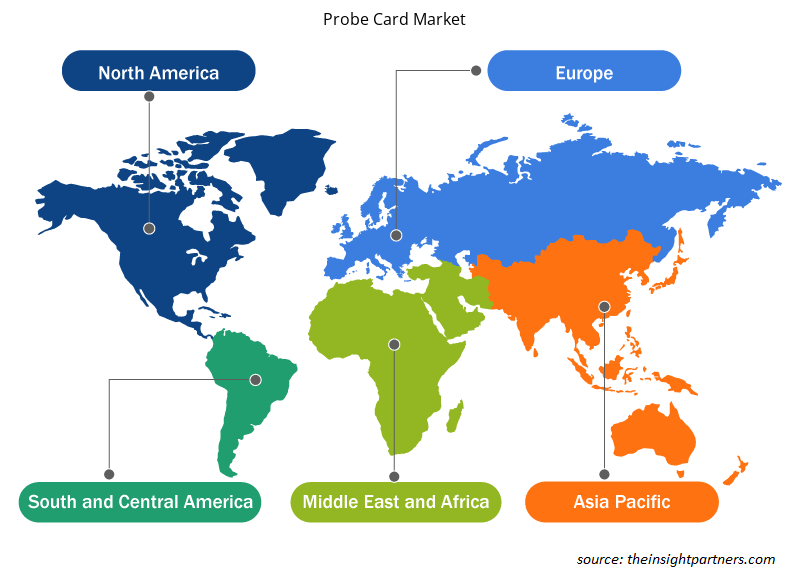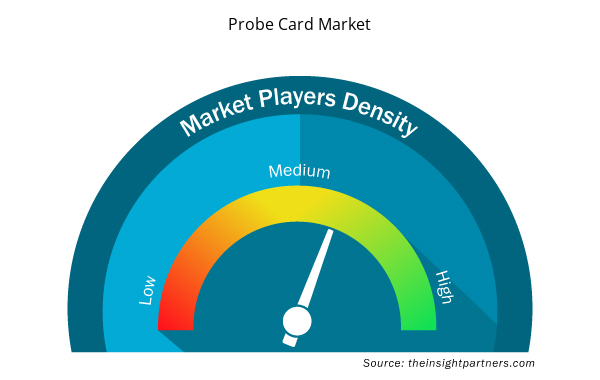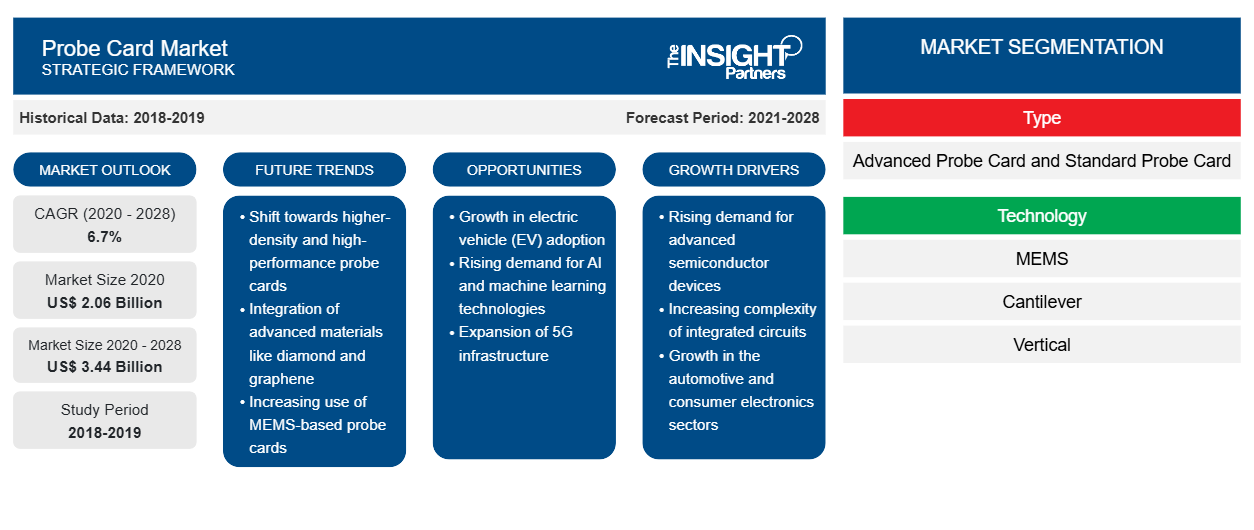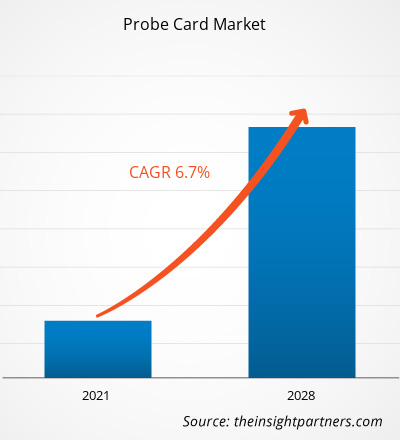Si prevede che il mercato delle schede di prova raggiungerà i 3.436,80 milioni di dollari entro il 2028, rispetto ai 2.059,80 milioni di dollari del 2020; si prevede una sana crescita del mercato pari al 6,7% di CAGR nel periodo 2021-2028.
Una scheda di prova è un'interfaccia che consente di testare un wafer di semiconduttore. Nella fase iniziale della produzione di semiconduttori, questa procedura viene utilizzata per valutare la qualità dei circuiti integrati o dell'indicizzazione semantica latente. Nella maggior parte dei casi, la scheda di prova è agganciata meccanicamente a un prober e collegata elettricamente a un tester. Lo scopo principale di una scheda di prova è stabilire una connessione elettrica tra l'apparecchiatura di prova e i circuiti sul wafer, consentendo di testare i circuiti. I circuiti stampati (PCB) e vari tipi di elementi di contatto sono i componenti fondamentali delle schede di prova. Una scheda di prova considera una varietà di elementi, alcuni dei quali sono piuttosto comuni e altri che hanno un uso altamente specifico.
Il settore dell'elettronica di consumo si è evoluto a seguito dell'aumento dell'uso di cellulari, computer desktop, fotocamere digitali, tablet, laptop, hard disk e televisori, tra le altre cose, nonché della ricerca e dell'introduzione costanti di nuove tecnologie. L'introduzione di gadget intelligenti e dell'Internet of Things, nonché l'accettazione crescente dei tablet e l'impennata della domanda di dispositivi con schermi enormi, stanno tutti contribuendo alla crescita del mercato delle sonde. La domanda di semiconduttori è stata alimentata dai cambiamenti nelle tendenze delle dimensioni dei chip e da una crescente preferenza per l'architettura creativa in vari prodotti elettronici. Le crescenti dimensioni della produzione di chip IC hanno determinato un boom nella domanda di test elettronici, che sta aumentando la necessità di schede di sonda. L'incorporazione di tecnologie moderne, come AI e IoT, nelle apparecchiature di produzione di semiconduttori accelererà la loro accettazione nelle strutture di fabbricazione. Inoltre, la crescente necessità di sensori al silicio per i dispositivi IoT, l'espansione della presenza dell'industria dei chip nei paesi emergenti e l'incremento del numero di data center e server sono fattori che contribuiscono ad aumentare le prestazioni dell'industria dei semiconduttori, che a loro volta contribuiscono ad aumentare la domanda di schede di controllo.
Il blocco mondiale per ridurre al minimo la trasmissione del virus ha interrotto in modo significativo le attività della catena di fornitura insieme al volume di produzione di diversi produttori, in particolare i proprietari di piccole e medie imprese. L'industria dei semiconduttori ha subito un duro colpo poiché la domanda di componenti elettronici è stata ridotta dal settore industriale e dagli utenti finali. Il modello di fatturato per la microelettronica è diminuito poiché non è stata effettuata alcuna produzione di massa nel periodo di blocco. Dopo il blocco, l'industria dei semiconduttori ha iniziato a riconquistare la quota di mercato poiché gli impianti di produzione hanno riavviato l'attività adottando misure di distanziamento sociale. Inoltre, anche il lavoro da casa e le strategie di monitoraggio remoto hanno contribuito ad aumentare le vendite di prodotti elettronici avanzati per una migliore connettività. L'importanza dell'IT e del settore delle telecomunicazioni è stata evidenziata per scopi comunicativi, il che ha consentito al settore di evolversi con nuove tecnologie come la connettività IoT e la tecnologia di confezionamento compatibile con Wi-Fi ad alta velocità.
Personalizza questo report in base alle tue esigenze
Riceverai la personalizzazione gratuita di qualsiasi report, comprese parti di questo report, o analisi a livello nazionale, pacchetto dati Excel, oltre a usufruire di grandi offerte e sconti per start-up e università
- Scopri le principali tendenze di mercato in questo rapporto.Questo campione GRATUITO includerà analisi di dati che spaziano dalle tendenze di mercato alle stime e alle previsioni.
In base al rapporto di mercato sulle schede di prova , si prevede che l'Asia Pacifica deterrà la maggioranza della quota di mercato globale delle schede di prova. L'Asia Pacifica comprende le economie più grandi e dinamiche come Cina, India, Giappone, Australia e Corea del Sud. Taiwan, Cina e Giappone sono i principali paesi produttori di semiconduttori nell'Asia Pacifica. L'aumento del reddito disponibile nei paesi in via di sviluppo come India e Cina sta portando a un'ampia base di clienti per l'elettronica di consumo ad alta tecnologia come dispositivi indossabili intelligenti, smartphone e veicoli elettrici. Si prevede che questo fattore guiderà il mercato delle schede di prova nella regione. La Cina è un importante polo manifatturiero per i prodotti basati sulla tecnologia di confezionamento IC, mentre Taiwan, Corea del Sud e Giappone contribuiscono in modo significativo alla crescita del mercato regionale. Molti dei paesi dell'Asia Pacifica sono caratterizzati dalla produzione di massa di dispositivi elettronici richiesti per l'elettronica di consumo, componenti automobilistici, dispositivi di telecomunicazione e altri macchinari industriali. Il crescente numero di aziende manifatturiere di elettronica in India e Cina, dovuto alla forte disponibilità di risorse umane qualificate, sta guidando la crescita del mercato delle schede di prova.
Segmenti di mercato delle schede di prova
Sulla base dell'analisi di mercato delle schede sonda, il mercato è segmentato in tipo, tecnologia, applicazione e geografia. Sulla base del tipo, il mercato delle schede sonda è segmentato in schede sonda avanzate e schede sonda standard. Sulla base della tecnologia, il mercato delle schede sonda è segmentato in MEMS, cantilever e verticale. E sulla base dell'applicazione, il mercato delle schede sonda è segmentato in fonderia e logica, DRAM, flash e altri. L'analisi geografica è condotta in base a regioni quali Nord America, Europa, Asia Pacifico (APAC) e Resto del mondo (RoW).
Alcuni dei principali attori del mercato delle schede sonda sono FEINMETALL GmbH; FormFactor; Fujitsu; GGB Industries; Japan Electronic Materials Corporation; Korea Instrument Co.,Ltd.; Micronics Japan Co., Ltd.; MPI Corporation; SV Probe; e Technoprobe SpA
Informazioni di mercato sulle schede di sonda basate sul tipo
In base al tipo, il mercato globale delle probe card è segmentato in advanced probe card e standard probe card. La probe card è un'interfaccia o una scheda utilizzata per condurre test wafer per un wafer semiconduttore. Esistono essenzialmente tre tipi di test che vengono eseguiti utilizzando una probe card: test DC, test AC e test funzionale.
Approfondimenti regionali sul mercato delle schede di prova
Le tendenze regionali e i fattori che influenzano il mercato delle Probe Card durante il periodo di previsione sono stati ampiamente spiegati dagli analisti di Insight Partners. Questa sezione discute anche i segmenti e la geografia del mercato delle Probe Card in Nord America, Europa, Asia Pacifico, Medio Oriente e Africa e Sud e Centro America.

- Ottieni i dati specifici regionali per il mercato delle schede sonda
Ambito del rapporto di mercato sulle schede sonda
| Attributo del report | Dettagli |
|---|---|
| Dimensioni del mercato nel 2020 | 2,06 miliardi di dollari USA |
| Dimensioni del mercato entro il 2028 | 3,44 miliardi di dollari USA |
| CAGR globale (2020 - 2028) | 6,7% |
| Dati storici | 2018-2019 |
| Periodo di previsione | 2021-2028 |
| Segmenti coperti | Per tipo
|
| Regioni e Paesi coperti | America del Nord
|
| Leader di mercato e profili aziendali chiave |
|
Densità degli attori del mercato: comprendere il suo impatto sulle dinamiche aziendali
Il mercato del Probe Card Market sta crescendo rapidamente, spinto dalla crescente domanda degli utenti finali dovuta a fattori quali l'evoluzione delle preferenze dei consumatori, i progressi tecnologici e una maggiore consapevolezza dei vantaggi del prodotto. Con l'aumento della domanda, le aziende stanno ampliando le loro offerte, innovando per soddisfare le esigenze dei consumatori e capitalizzando sulle tendenze emergenti, il che alimenta ulteriormente la crescita del mercato.
La densità degli operatori di mercato si riferisce alla distribuzione di aziende o società che operano in un particolare mercato o settore. Indica quanti concorrenti (operatori di mercato) sono presenti in un dato spazio di mercato in relazione alle sue dimensioni o al valore di mercato totale.
Le principali aziende che operano nel mercato delle schede sonda sono:
- FEINMETALL GmbH
- Fornitore di servizi di stampa e pubblicità
- Fujitsu
- Industrie GGB
- Società giapponese di materiali elettronici
Disclaimer : le aziende elencate sopra non sono classificate secondo un ordine particolare.

- Ottieni la panoramica dei principali attori del mercato delle schede di prova
I player profilati nel rapporto di mercato delle schede di sonda si concentrano principalmente sullo sviluppo di prodotti avanzati ed efficienti. Le aziende del mercato delle schede di sonda stanno implementando varie strategie per adeguarsi ai progressi tecnologici nel mercato delle schede di sonda.
- Nel 2020, FormFactor ha annunciato la famiglia di sonde criogeniche per le applicazioni informatiche emergenti.
- Nel 2020 Technoprobe ha acquisito Microfabrica.
- Analisi storica (2 anni), anno base, previsione (7 anni) con CAGR
- Analisi PEST e SWOT
- Valore/volume delle dimensioni del mercato - Globale, regionale, nazionale
- Industria e panorama competitivo
- Set di dati Excel



Report Coverage
Revenue forecast, Company Analysis, Industry landscape, Growth factors, and Trends

Segment Covered
This text is related
to segments covered.

Regional Scope
North America, Europe, Asia Pacific, Middle East & Africa, South & Central America

Country Scope
This text is related
to country scope.
Domande frequenti
Increasing penetration of consumer electronics and rise in manufacturing of semiconductor chips due to proliferating automotive sector are driving the growth of the global probe card market.
On the basis of type segment, the probe card market is segmented into advanced probe card and standard probe card. The advanced probe card segment led the global probe card market with a market share of 77.5% in 2020. Further, it is expected to garner 80.2% share by 2028.
APAC led the market with a highest revenue share in 2020, and it is also expected to register the fastest CAGR during the forecast period. China, Japan, and South Korea are among the major contributors to the probe card market growth in APAC. The electronics industries in China and Japan represent huge potential for the manufacturing and sale of probe card devices. Similarly, many APAC countries are characterized by the mass production of electronic components required for consumer electronics, automotive devices, telecommunication devices, and other industrial machinery. Rising number of electronics manufacturing companies in India and China owing to the availability of skilled human resources is driving the probe card market growth. The growing production of ICs in APAC is also another factor driving the probe card market growth.
Trends and growth analysis reports related to Electronics and Semiconductor : READ MORE..
The List of Companies - Probe Card Market
- FEINMETALL GmbH
- FormFactor, Inc.
- Fujitsu
- GGB Industries
- Japan Electronic Materials Corporation
- Korea Instrument Co., Ltd.
- MPI Corporation
- SV Probe
- Technoprobe S.p.A.
- Micronics Japan Co., Ltd.
The Insight Partners performs research in 4 major stages: Data Collection & Secondary Research, Primary Research, Data Analysis and Data Triangulation & Final Review.
- Data Collection and Secondary Research:
As a market research and consulting firm operating from a decade, we have published and advised several client across the globe. First step for any study will start with an assessment of currently available data and insights from existing reports. Further, historical and current market information is collected from Investor Presentations, Annual Reports, SEC Filings, etc., and other information related to company’s performance and market positioning are gathered from Paid Databases (Factiva, Hoovers, and Reuters) and various other publications available in public domain.
Several associations trade associates, technical forums, institutes, societies and organization are accessed to gain technical as well as market related insights through their publications such as research papers, blogs and press releases related to the studies are referred to get cues about the market. Further, white papers, journals, magazines, and other news articles published in last 3 years are scrutinized and analyzed to understand the current market trends.
- Primary Research:
The primarily interview analysis comprise of data obtained from industry participants interview and answers to survey questions gathered by in-house primary team.
For primary research, interviews are conducted with industry experts/CEOs/Marketing Managers/VPs/Subject Matter Experts from both demand and supply side to get a 360-degree view of the market. The primary team conducts several interviews based on the complexity of the markets to understand the various market trends and dynamics which makes research more credible and precise.
A typical research interview fulfils the following functions:
- Provides first-hand information on the market size, market trends, growth trends, competitive landscape, and outlook
- Validates and strengthens in-house secondary research findings
- Develops the analysis team’s expertise and market understanding
Primary research involves email interactions and telephone interviews for each market, category, segment, and sub-segment across geographies. The participants who typically take part in such a process include, but are not limited to:
- Industry participants: VPs, business development managers, market intelligence managers and national sales managers
- Outside experts: Valuation experts, research analysts and key opinion leaders specializing in the electronics and semiconductor industry.
Below is the breakup of our primary respondents by company, designation, and region:

Once we receive the confirmation from primary research sources or primary respondents, we finalize the base year market estimation and forecast the data as per the macroeconomic and microeconomic factors assessed during data collection.
- Data Analysis:
Once data is validated through both secondary as well as primary respondents, we finalize the market estimations by hypothesis formulation and factor analysis at regional and country level.
- Macro-Economic Factor Analysis:
We analyse macroeconomic indicators such the gross domestic product (GDP), increase in the demand for goods and services across industries, technological advancement, regional economic growth, governmental policies, the influence of COVID-19, PEST analysis, and other aspects. This analysis aids in setting benchmarks for various nations/regions and approximating market splits. Additionally, the general trend of the aforementioned components aid in determining the market's development possibilities.
- Country Level Data:
Various factors that are especially aligned to the country are taken into account to determine the market size for a certain area and country, including the presence of vendors, such as headquarters and offices, the country's GDP, demand patterns, and industry growth. To comprehend the market dynamics for the nation, a number of growth variables, inhibitors, application areas, and current market trends are researched. The aforementioned elements aid in determining the country's overall market's growth potential.
- Company Profile:
The “Table of Contents” is formulated by listing and analyzing more than 25 - 30 companies operating in the market ecosystem across geographies. However, we profile only 10 companies as a standard practice in our syndicate reports. These 10 companies comprise leading, emerging, and regional players. Nonetheless, our analysis is not restricted to the 10 listed companies, we also analyze other companies present in the market to develop a holistic view and understand the prevailing trends. The “Company Profiles” section in the report covers key facts, business description, products & services, financial information, SWOT analysis, and key developments. The financial information presented is extracted from the annual reports and official documents of the publicly listed companies. Upon collecting the information for the sections of respective companies, we verify them via various primary sources and then compile the data in respective company profiles. The company level information helps us in deriving the base number as well as in forecasting the market size.
- Developing Base Number:
Aggregation of sales statistics (2020-2022) and macro-economic factor, and other secondary and primary research insights are utilized to arrive at base number and related market shares for 2022. The data gaps are identified in this step and relevant market data is analyzed, collected from paid primary interviews or databases. On finalizing the base year market size, forecasts are developed on the basis of macro-economic, industry and market growth factors and company level analysis.
- Data Triangulation and Final Review:
The market findings and base year market size calculations are validated from supply as well as demand side. Demand side validations are based on macro-economic factor analysis and benchmarks for respective regions and countries. In case of supply side validations, revenues of major companies are estimated (in case not available) based on industry benchmark, approximate number of employees, product portfolio, and primary interviews revenues are gathered. Further revenue from target product/service segment is assessed to avoid overshooting of market statistics. In case of heavy deviations between supply and demand side values, all thes steps are repeated to achieve synchronization.
We follow an iterative model, wherein we share our research findings with Subject Matter Experts (SME’s) and Key Opinion Leaders (KOLs) until consensus view of the market is not formulated – this model negates any drastic deviation in the opinions of experts. Only validated and universally acceptable research findings are quoted in our reports.
We have important check points that we use to validate our research findings – which we call – data triangulation, where we validate the information, we generate from secondary sources with primary interviews and then we re-validate with our internal data bases and Subject matter experts. This comprehensive model enables us to deliver high quality, reliable data in shortest possible time.


 Ottieni un campione gratuito per questo repot
Ottieni un campione gratuito per questo repot